|
|
|
Sort Order |
|
|
|
Items / Page
|
|
|
|
|
|
|
| Srl | Item |
| 1 |
ID:
190841
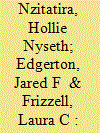

|
|
|
|
|
| Summary/Abstract |
Recent studies of genocide have yielded varying estimates of the number and characteristics of people who engaged in violence. We address these disparities in estimates for one well-studied case: the 1994 genocide in Rwanda. Using novel data from Rwanda’s post-genocide gacaca courts, we provide updated estimates regarding participants. Specifically, we find that between 847,233 and 888,307 people participated in the genocide, with 181,280 to 190,113 people found guilty of only violent offenses, 618,164 to 654,152 individuals found guilty of only property crimes, and 44,042 to 47,789 individuals found guilty of both property and violent crimes. In total, we estimate that between 229,069 and 234,155 individuals were found guilty of a violent offense, including those who committed violent offenses as well as both violent and property offenses. These results align with past research, representing an important convergence of evidence regarding participation in this genocide. We also calculate specific characteristics of participants, finding that nearly 90% of all participants were men and that the median age for all participants was 34. Although most participants committed a single crime, between 215,124 and 222,522 people were found guilty of multiple crimes. Approximately 6% of people accounted for 25% of the property crimes, while 11% of people accounted for 25% of the violent crimes. These findings provide foundational information about one of the deadliest episodes of mass violence in the 20th century.
|
|
|
|
|
|
|
|
|
|
|
|
|
|
|
|
| 2 |
ID:
190840
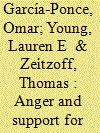

|
|
|
|
|
| Summary/Abstract |
How does exposure to criminal violence shape attitudes towards justice and the rule of law? Citizens care about crime prevention and procedural legality, yet they also value punishing perpetrators for the harm they have done. We argue that anger induced by exposure to criminal violence increases the demand for retribution and harsh punishments, even at the expense of the rule of law. We test this theory using one observational and two experimental studies from an original survey of 1,200 individuals in Western Mexico, a region affected by organized criminal violence and vigilantism. First, we first show that exposure to violence is correlated with increased anger and support for punitive justice, including vigilante actions. Second, across our two experiments, we show that citizens are more supportive of harsh punishments and place less value on their legality in response to morally outrageous crimes. Third, we find that the innocence of the victim, rather than the severity of the crime, is what triggers outrage and punitiveness. This suggests that citizens may support extreme levels of violence as long as they perceive that its targets are criminals. Finally, we show that outrageous forms of violence against civilians can lead individuals to prioritize harsh punishment regardless of its legality. When criminal actors target perceived innocents with common crimes like extortion, there is greater support for harsh, vigilante action. These patterns provide a bottom-up explanation for harsh justice.
|
|
|
|
|
|
|
|
|
|
|
|
|
|
|
|
| 3 |
ID:
190835
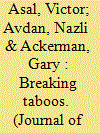

|
|
|
|
|
| Summary/Abstract |
Much ado has been made about the specter of unconventional weapons in the hands of militant groups. Despite the alarmism of the policy community, the pursuit of chemical, biological, radiological, and nuclear capabilities by non-state actors is rare. What explains why some violent non-state organizations pursue chemical, biological, radiological, and nuclear weapons while most do not? Using new data on organizational behaviors and attributes from the Big Allied and Dangerous 2 Insurgency project, we analyze 140 insurgent actors, from 1998 to 2012. We expand previous work by Asal, Ackerman & Rethemeyer by studying the phenomenon longitudinally and attending to organizational behavior rather than only to structural and environmental factors. We find that organizations that attack cultural sites are more likely to pursue and use chemical, biological, radiological, and nuclear weapons. We interpret the latter as a willingness to transgress upon accepted mores, for the sake of sensationalism and shock value, which coheres with a willingness to pursue unconventional weapons. Our results reflect that chemical, biological, radiological, and nuclear pursuit and use is part of a larger strategy for some violent non-state organizations, one predicated on generating mass fear and exacting a psychological toll.
|
|
|
|
|
|
|
|
|
|
|
|
|
|
|
|
| 4 |
ID:
190846


|
|
|
|
|
| Summary/Abstract |
We introduce a new dataset, Contemporary Slavery in Armed Conflict (CSAC), coding instances and types of enslavement in armed conflict from 1989 to 2016, building on Uppsala Conflict Data Program data. CSAC currently covers 171 armed conflicts from 1989 to 2016, with the unit of analysis being the conflict-year. We identify different types of enslavement within these conflicts and find that 87% contained incidences of child soldiers, 34% included sexual exploitation/forced marriage, 23% included forced labor, and 16% contained instances of human trafficking. The use of enslavement in armed conflict to support strategic aims is also identified and found in about 17% of cases. Next, drawing upon key variables from the Uppsala Conflict Data Program, we present a series of cross-tabulations looking at the presence of slavery and conflict broken down by conflict incompatibility, intensity level, and type. We see the coding of slavery within conflict as a step toward generating greater understanding of when and how state and non-state actors use enslavement within conflict, with the goal of mitigating and possibly eradicating slavery in warfare.
|
|
|
|
|
|
|
|
|
|
|
|
|
|
|
|
| 5 |
ID:
190843
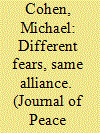

|
|
|
|
|
| Summary/Abstract |
How do power, interests and threats influence the creation of military alliances? Under what conditions do multilateral and bilateral alliances emerge? Are shared threat perceptions necessary for alliance creation? This article addresses these longstanding questions through developing and refining theories of alliance creation and design and tests them using new archival data from Australia and the United States. The theory and empirics refine balance of threat theory through developing and/or testing other theories regarding the balance of power, threat perception, assurance, signalling and control. Empirically, the article shows that although after the 1950 Korean War the United States wanted Japan to be capable of withstanding Soviet and Chinese challenges, Australia, New Zealand and the Philippines feared that this would allow future Japanese naval militarism. Truman sought to secure regional buy-in to his Japanese settlement through one multilateral alliance, given bilateralism’s costs of assuring multiple allies, but had to settle for several bilateral alliances given regional refusal to ally with Japan. The findings show that bilateral alliances incur previously neglected ‘assurance costs’ and that alliances are possible between states with divergent threat perceptions.
|
|
|
|
|
|
|
|
|
|
|
|
|
|
|
|
| 6 |
ID:
190842
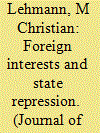

|
|
|
|
|
| Summary/Abstract |
Existing work seeks explanations for state repression mainly in domestic factors such as ethnic/religious cleavages, poverty and inequality, struggle for power, regime type and quality of state institutions, lack of loyalty, demand for scapegoats, and cultural or psychological traits of perpetrators. How foreign influences shape state repression has been given less attention. Furthermore, the focus of the empirical literature has been largely cross-country, leaving much local variation unexplained. In this article, I examine how far foreign interests can explain the local (spatial) variation of deportations and massacres during the Armenian genocide. Between 1915 and 1917 the Ottoman Empire carried out a massive campaign of state repression (deportations and massacres) against its Armenian population. There was meaningful variation across Ottoman provinces in the intensity of this campaign, that is, some provinces experienced more repression than others. I investigate the determinants of this spatial variation. My empirical analysis is guided by a rationalist (economic) model where deportation is a tool to stifle Armenian calls for independence, but the benefit and cost of deportation vary spatially. For example, deportation is costlier (i.e. the risk of foreign intervention is greater) in locations where foreign economic and military interests are threatened by the departure of Armenians. In line with the model’s predictions, my empirical analysis indicates that there were fewer deportations in places where Armenians worked for the German-owned railway.
|
|
|
|
|
|
|
|
|
|
|
|
|
|
|
|
| 7 |
ID:
190838


|
|
|
|
|
| Summary/Abstract |
This article evaluates the extent to which armed conflicts influence early childhood health for 56 developing countries over nearly 30 years. Exploiting both spatial and temporal variations in conflict exposure within a difference-in-differences framework, the article uncovers detrimental ramifications of armed conflicts on the health outcomes of children under five years old. Particularly, children exposed to armed conflicts have lower height-for-age, weight-for-height, and weight-for-age z-scores by 0.08, 0.05, and 0.10 standard deviations, respectively. Taking the average corresponding anthropometric z-scores of unexposed children as the benchmarks, exposure to armed conflicts makes children 6.6% shorter for their age, 11% thinner for their height, and 9% thinner for their age. Exposure to armed conflicts further makes children 2.2, 0.8, and 2.6 percentage points more likely to be stunted, wasted, and underweight, respectively (i.e. 7.3%, 7.9%, and 10.2% increases compared to the benchmark averages of those unexposed to armed conflicts). In addition, the heterogeneity analyses suggest that children born to low-education mothers, children from relatively poor households, and children living in rural areas tend to bear the larger health setbacks. Given the long-lasting impacts of poor health in early childhood on adult outcomes, delivering nutrition interventions to children in conflict zones is of utmost importance, and extra attention should be given to children of disadvantaged backgrounds.
|
|
|
|
|
|
|
|
|
|
|
|
|
|
|
|
| 8 |
ID:
190847
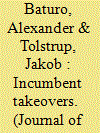

|
|
|
|
|
| Summary/Abstract |
The expansion of power by incumbent political leaders has become the subject of increased scholarly attention. In democracies, this is known as ‘subversions by the ruling executive’, ‘executive aggrandizement’, or ‘autogolpe’; in autocracies, researchers study ‘personalization’, ‘transition to personal rulership’, or ‘power-grabbing’. While the terminological landscape is rich, there is little conceptual agreement of what leader-driven power expansion is (and is not). Furthermore, we still lack broad data that allow us to investigate the phenomenon systematically across democracy and autocracy. The contribution of this article is twofold. First, it offers a unified approach to study leader-driven power expansion – incumbent takeovers – across the political regime spectrum. Second, drawing from 11 datasets and original data collection and coding, we introduce a new, comprehensive dataset on 495 individual takeover events carried out by 279 political leaders in 132 countries in the period 1918–2019. We provide estimates of the takeover onset years, the time to takeover, the length of the takeover spells, and discuss the differences between distinct indicators, inter alia. Future research may leverage these data for a better understanding of the drivers of incumbent takeovers as well as the role of takeovers in regime change, civil wars, coups, and uprisings.
|
|
|
|
|
|
|
|
|
|
|
|
|
|
|
|
| 9 |
ID:
190845
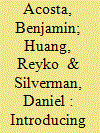

|
|
|
|
|
| Summary/Abstract |
Existing literature on civil wars relies predominantly on state- and organization-level variables to understand conflict dynamics and outcomes. In this article, we propose that rebel leaders’ personal backgrounds and experiences are also key to explaining the behavior of the organizations they lead. Just as scholars have long highlighted the importance of state leaders’ biographical characteristics in interstate war and diplomacy, we argue that the attributes of rebel leaders affect their organizations’ decisions and actions in civil war. To substantiate our claims, we introduce the Rebel Organization Leaders (ROLE) database, which contains a wide range of biographical information on all top rebel leaders in civil wars ongoing between 1980 and 2011. We first describe the contents of the database and present a number of novel descriptive findings about rebel leaders. To illustrate its utility, we then examine the influence of rebel leaders’ attributes on their organizations’ use of terrorism in civil war. Ultimately, our work encourages – and enables – a new research agenda that goes beyond rebel organizations and campaigns as units of analysis and brings individual leaders more fully into modern conflict and peace studies.
|
|
|
|
|
|
|
|
|
|
|
|
|
|
|
|
| 10 |
ID:
190837
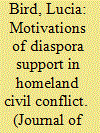

|
|
|
|
|
| Summary/Abstract |
Although diasporas often leave their homelands due to violence or political upheaval, these groups may engage in homeland politics by providing financial, material, or diplomatic assistance to militants engaged in civil conflicts. Conversely, diasporas may ignore homeland civil conflicts and exclusively focus on opportunities available in their host states. This study argues that variation in diasporas’ degree of integration into their host states influences whether diasporas support militants opposing homeland governments. Diaspora members may be dissimilated, which undermines their ability to consolidate resources in support of homeland militants, or incorporated, which limits their will to engage in homeland civil conflicts. Moderately integrated diasporas, which maintain identity ties with the homeland and have access to beneficial resources, are most likely to aid militants fighting homeland civil conflicts. Using original data, I test and find support for this integration-based theory.
|
|
|
|
|
|
|
|
|
|
|
|
|
|
|
|
| 11 |
ID:
190844
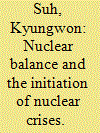

|
|
|
|
|
| Summary/Abstract |
The nuclear competition school, an emerging theoretical perspective on the political effect of nuclear weapons, argues that a favorable nuclear balance can significantly reduce one’s expected costs of nuclear war and therefore affect the interaction between nuclear-armed states, such as deterrence and crisis outcomes. This new perspective also presents a wide array of empirical evidence demonstrating the significant effect of the nuclear balance of power on political outcomes, thereby challenging the theory of the nuclear revolution, which argues that the nuclear balance of power produces no meaningful effects on political outcomes because no state can escape costly nuclear destruction. Little attention, however, has been paid to systematically exploring the effect of the nuclear balance on the initiation of nuclear crises. This is surprising, given that observable factors, such as the nuclear balance, should have a powerful effect at the crisis initiation stage because countries can observe military balance and assess the costs and benefits of entering a crisis. This article tests a core argument of the nuclear competition school regarding the effect of the nuclear balance on the initiation of nuclear crises. With original data on strategic nuclear balance, my statistical analysis shows that having a superior nuclear arsenal than another nuclear-armed opponent does not lead to a reduced likelihood of nuclear crisis initiated by the opponent. These core findings hold after conducting a series of robustness tests with various measures of the balance of nuclear forces. They encourage us to reconsider the persuasiveness of the nuclear competition school and offer implications for US nuclear policy and force size.
|
|
|
|
|
|
|
|
|
|
|
|
|
|
|
|
| 12 |
ID:
190839


|
|
|
|
|
| Summary/Abstract |
In states emerging from mass violence and human rights abuses, do individuals prefer retributive punishment of perpetrators through trials, or do they wish to be compensated with land or monetary reparations for their injuries? How does the concrete option of prosecutions by the International Criminal Court (ICC) moderate these preferences? Using unique survey data from 507 Kenyans collected in 2015, we build on and add nuance to the empirical literature that interrogates the link between exposure to mass violence and post-conflict justice preferences. We find that while some individuals prefer reparative justice, victims and witnesses generally want perpetrators to be prosecuted. Even for those who are co-ethnics of government leaders – who allegedly instigated widespread killing, sexual assaults and displacements – direct exposure to those acts leads to greater desire for prosecutions. We further find that one’s personal experience with violence also leads one to reject domestic justice in favor of international justice: victims and witnesses who favored retributive justice are highly likely to believe that the ICC is the best option for prosecuting perpetrators.
|
|
|
|
|
|
|
|
|
|
|
|
|
|
|
|
| 13 |
ID:
190836
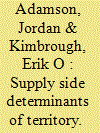

|
|
|
|
|
| Summary/Abstract |
This article introduces a simple application of contest theory that neatly captures how Boulding’s ‘loss of strength gradient’ determines the geographic extent of territory. We focus on the ‘supply side’ of territorial conflict, showing how the costs of initiating and escalating conflict over spatially dispersed resources shape the nature and scope of territory. We show that economies of scale in the production of violence and varying costs of projecting power at a distance combine to affect the intensive and extensive margins of conflict, and ultimately the geographic distribution of territory. Comparative statics analysis shows how the distribution of conflict and territory change as costs change, helping shed light on, for example, why new transportation technologies have historically led to a redrawing of territorial boundaries. We test and probe the boundaries of this model in two experiments varying the marginal costs of conflict over space and the fixed costs of entry. Increases in both costs interact to increase the probability of exclusive territories. The first experiment directly tests the theory in a static, one-shot setting that strictly matches the information conditions studied in the theory. The second experiment examines conflict behavior under conditions analogous to those in conflicts outside the lab: where no contestant knows the probability of winning, let alone the function determining that probability, and parties interact repeatedly. Median behavior closely tracks equilibrium predictions in all treatments.
|
|
|
|
|
|
|
|
|
|
|
|
|
|
|
|
|
|
|
|
|